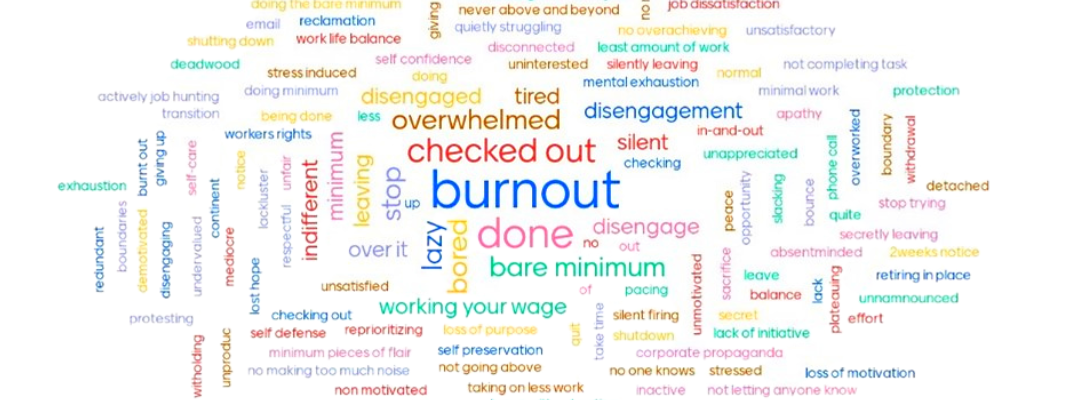At the recent PowerTools for Nonprofits Conference in Houston, I had the privilege of presenting to over 100 nonprofit professionals about emerging leadership, leadership development opportunities and how to take ownership of your own career trajectory. In this, we explored the current employment environment in the sector with respect to trends, which allowed me to gather feedback from the participants on the term ‘Quiet Quitting’ and to think through how that compared with the word summary definition stated on dictionary.com.
Quiet quitting - is an informal term for the practice of reducing the amount of effort one devotes to one’s job, such as by stopping the completion of any tasks not explicitly stated in the job description. The term implies that this is done secretly or without notifying one’s boss or manager.

A few of the participants' ideas on the definition that struck me include:
• Burnout
• Retiring in Place
• Working Your Wage
• Plateauing
• Overworked
• Lazy
• Least Amount of Work
• Actively Job Hunting
There are debates currently going on regarding the use of this term in a pejorative manner about worker engagement. In the context of mental health and setting boundaries on professional/personal time – where do you draw the line between this concept showing up as a healthy balance for work expectations vs. having high expectations for your team members?
The audience was a combination of individual contributors, managers and senior leaders. The responses to the question asked included quite a range of perceptions. It made me think about our individual viewpoint and how that plays out in terms of the outcome of an employee moving from a perceived high performer (above and beyond job duties) to an employee fulfilling the stated requirements of their job. What is the role of a leader in navigating this or managing the resources of an organization so that it doesn’t get to a breaking point for the employee? Plainly put, can your expectations be both reasonable and high, and is there a balance that meets both?
What does the juxtaposition mean here in context of a sector that thrives on “doing more with less?” Is this a concept that should bring up concern from a manager in terms of disappointment with the employee or concern that the organization should reexamine priorities for resource allocation?
From a leadership perspective, how does your organization measure performance? Is the baseline of satisfactory work established in your job description or must an employee actually perform above expectation (i.e., the job description) in order to provide the service your organization offers? If the latter is the case and everyone must operate at their highest level in order to meet the minimum expectations of your organization, then are you using your most precious resource – the time and talents of your team – in an effective manner? Are you accurately depicting the resources you need to meet your program expectations?
These questions are ones that can lead you to reevaluate your organization’s structure and strategy. They are challenging questions to address, but strong leaders can and should approach this as an opportunity to review and ultimately support the needs of your organization.
There are numerous examples of organizations that have lost a high performer only to find they must hire several positions to backfill the actual work this employee was doing on a regular basis. What if that high performer and their contributions had been handled differently? Where would your organization be now if the high performer stayed?
So, where does this leave us? As emerging leaders, it is important to note your own boundaries and set expectations accordingly, but setting boundaries doesn’t have to mean that you are not a high performer. As managers and senior leaders, it is important to recognize that continuing to rely on maximum performance to meet the minimum organization expectations does not set you up for sustained success or build a pipeline of leaders that will stay and grow with your organization.
As you move forward in your quest to develop as a leader or work with your emerging leaders, seek to understand what expectations your organization sets for team members and how those align with the reality of what your team can give on a regular basis. Effective stewardship is not just a matter of funding, but how we utilize all our assets, positioning them for maximized organizational success.
About the Author

Kristen Schlatre, CFRE, is the Director of the Center for Philanthropy and Nonprofit Leadership. She is responsible for implementing the strategic direction of the Center through ensuring the continued quality and growth of the nonprofit program portfolio for the Glasscock School This includes overseeing curriculum design, partnership management, program development and administration of programming serving nonprofit professionals, volunteers and board members.
The Center for Philanthropy & Nonprofit Leadership provides professional development instruction and consulting for nonprofits as they strengthen their leadership, staffing, governance, finance and fundraising capacity. We offer online and in-person courses for individuals and customized engagements for nonprofit organizations. Learn more at cpnl.rice.edu.
Read Next
On the Blog: The Center for Philanthropy & Nonprofit Leadership Portfolio
On the Blog: Which nonprofit leadership certificate is right for you?
Impact Report: Give Back. Move Forward.

